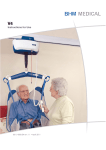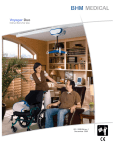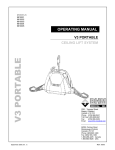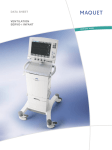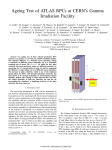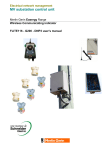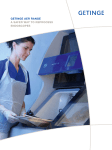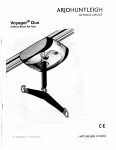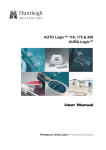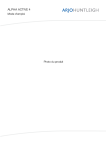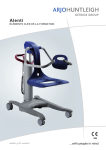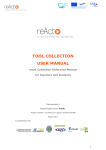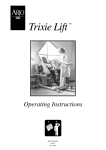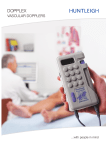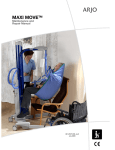Download Maxi Sky 600.book - Lancaster University
Transcript
Maxi Sky600, Maxi Sky600 ECS Instructions for Use 001.14150.33.EN rev. 7 • December 2010 ...with people in mind ArjoHuntleigh International AB. © ArjoHuntleigh International 2010 ArjoHuntleigh products are patented or patent pending. Patent information is available by contacting ArjoHuntleigh International AB. Our policy is one of continuous development, and we therefore reserve the right to make technical alterations without notice. The content of this publication may not be copied either whole or in part without the consent of ArjoHuntleigh International AB. Table of Contents General Information ............................................................................................... 5 Foreword ......................................................................................................... 5 Service and support ...................................................................................... 5 Manufacturer Information ............................................................................... 6 Authorized European Representative ........................................................... 6 Definitions Used in this Manual: ................................................................. 6 Intended Use ................................................................................................. 6 Operational Life ........................................................................................... 6 Equipment Identification .............................................................................. 7 Verifying the Package Contents ................................................................... 7 How to Use this Manual ............................................................................... 7 Symbols Used ................................................................................................. 8 Safety Instructions................................................................................................... 9 General Instructions ........................................................................................ 9 Safe Working Load ...................................................................................... 9 Important Safety Directions ............................................................................ 10 Shock Prevention .......................................................................................... 10 Fire and Explosion Prevention ........................................................................ 11 Human and Environmental Safety Practices ................................................... 11 Battery and Battery Charger Safety Practices ................................................. 11 Equipment Warning Labels .......................................................................... 11 Part Designation ...................................................................................................... 12 Maxi Sky600 Ceiling Lift and Charger Station ................................................ 12 Legend .......................................................................................................... 12 Handset ............................................................................................................ 13 Chargers .......................................................................................................... 13 ECS Track System .......................................................................................... 13 Slings......................................................................................................................... 14 Compatible Slings ........................................................................................... 14 How to Use the Maxi Sky600 Ceiling lift................................................................. 15 Return to Charge (RTC), Return to Home (RTH) ....................................... 16 Emergency Stop (red cord) .......................................................................... 16 Emergency Lowering ................................................................................... 16 Emergency Brake ......................................................................................... 17 Battery Information ......................................................................................... 18 Indicator Lights ............................................................................................... 18 Charging the Batteries .................................................................................. 18 Programming the Ceiling Lift ......................................................................... 20 Using the FIDO Function (Pre-Programmed Positions) ................................. 20 Use of Slings ................................................................................................... 20 Spreader Bars and Stretcher Frame .............................................................. 20 Slings ............................................................................................................ 20 Before Approaching the Patient ................................................................... 21 3 Table of Contents Installing the sling on the Dynamic Positioning System (DPS) ..................... 21 To lift a Patient from a bed ........................................................................... 21 To lift a Patient from a chair ........................................................................ 24 To lift a Patient from the floor ..................................................................... 26 Procedure for Using Loop Slings with a Two-Point Spreader Bar .............. 27 To Lift a Patient from a Bed ......................................................................... 28 To Lift a Patient from a Chair ...................................................................... 28 To Lift a Patient from the Floor ................................................................... 29 Before Transferring a Patient ....................................................................... 29 Using Stretcher Frames and Stretchers ........................................................ 29 Operating the DPS .......................................................................................... 30 Caring for your DPS ..................................................................................... 30 Operating the Exchanger ................................................................................. 32 Operating the Turntable .................................................................................. 32 Maxi Sky600 Programming...................................................................................... 33 Changing the Speed of Movement ............................................................... 33 Adjusting the Spreader Bar Height .............................................................. 34 Enable/Disable Return to Charge (RTC) ..................................................... 35 Care and Maintenance ............................................................................................ 36 Preventive Maintenance Schedule .................................................................. 36 User Inspections .............................................................................................. 36 Inspections by an Authorized Service Technician .......................................... 37 Daily Checklist ................................................................................................ 39 Inspection and Cleaning ............................................................................... 39 Strap Inspection ............................................................................................ 39 Handling and Storage ...................................................................................... 40 Battery Replacement .................................................................................... 40 Verification of the Charger’s Power Source ................................................ 40 Sling Inspection and Care ............................................................................... 40 Regular Inspections ...................................................................................... 40 Sling Laundering .......................................................................................... 40 Annual Inspection ........................................................................................... 41 Maintenance Requirements .......................................................................... 41 Troubleshooting....................................................................................................... 42 Labels on the Lift..................................................................................................... 44 Technical Specifications.......................................................................................... 45 Lift Dimensions ............................................................................................... 47 Electromagnetic Compatibility .............................................................................. 48 Electromagnetic Compliance .......................................................................... 48 Electromagnetic Emissions ............................................................................. 48 Electromagnetic Immunity .............................................................................. 49 4 General Information Thank you for purchasing the Maxi Sky600 ceiling lift from ArjoHuntleigh. Your Maxi Sky600 is part of a series of quality products designed specially for home care, nursing homes and other health care uses. We are dedicated to serving your needs and providing the best products available along with training that will bring your staff maximum benefit from every ArjoHuntleigh product. Please read this manual thoroughly, and contact us if you have any questions about the operation or maintenance of your ArjoHuntleigh equipment. Foreword Please read this manual in its entirety before using your Maxi Sky600. The information in this manual is crucial to the proper operation and maintenance of the equipment, and will help protect your product as well as ensure that the equipment performs to your satisfaction. Lifting and transferring a person always presents a potential risk. Some of the information in this manual is important for your safety and must be read and understood to help prevent injuries. ArjoHuntleigh strongly advises and warns that to avoid injuries that can be attributed to the use of inadequate parts, only parts designated by ArjoHuntleigh should be used on equipment and other appliances supplied by ArjoHuntleigh. Furthermore, unauthorized modifications on any ArjoHuntleigh equipment may affect its safety. ArjoHuntleigh will not be held responsible for any accidents, incidents or deficiencies of performance that occur as a result of any unauthorized modification to its products. Tested according to standards by TUV Product Service and CSA. Service and support A service routine must be performed on your Maxi Sky600 by qualified service personnel. This will ensure the safety and good functioning of your product. See section called “Care and Maintenance” in this manual. If you require further information, please contact your local ArjoHuntleigh representative which can offer comprehensive support and service programs to maximize the long-term reliability, safety and value of the product. Contact your local representative for replacement parts. Additional copies of this manual can be purchased from your local ArjoHuntleigh representative. When ordering, include the Instructions for Use product number (see front page) and equipment identification number. 5 General Information Manufacturer Information Operational Life This product has been manufactured by: BHM Medical Inc. 2001 Tanguay Street Magog (Quebec) Canada J1X 5Y5 The equipment is designed and tested for a useful life of seven (7) years or 10,000 transfers—whichever comes first—subject to preventative maintenance as specified in the “Care and Maintenance” section in this manual. Time equivalence between the number of transfers versus the number of years is made clear in the table in Fig. 1. Authorized European Representative Huntleigh Healthcare Ltd. 310-312 Dallow rd. Luton, UK LU1 1TD Years Definitions Used in this Manual: WARNING: Transfers per Day (10,000 transfers) 4 7 6 4.5 8 3.5 Fig. 1 Means: Failure to understand and follow these instructions may result in injury to yourself and others. WARNING: The manufacturer cannot ensure full safety for a ceiling lift or an accessory of which the life span has been exceeded. CAUTION: Means: Failure to follow these instructions may cause damage to the product. The red indicator light on the ceiling lift will blink when it is about halfway to its useful life, and again to indicate the end of the useful life period. NOTE: The operating life of this equipment corresponds directly to the safe operating time period before a complete overhaul is required. Aging of the cassette, frequency of use (transfers per day), the weight of the patient and maintenance frequency are factors that have an impact on the Maxi Sky600’s life span. A transfer is defined as the displacement of a patient from one point to another. A transfer cycle includes a lifting and a descending action. Means: This is important information regarding the correct use of the equipment. Intended Use The Maxi Sky600 is designed for lifting patients in a homecare setting, at nursing homes and other assisted living centers. Patient transferring is performed under the supervision of an appropriately trained caregiver staff in accordance with the instructions outlined in this manual. All other uses must be avoided. The expected operational life for fabric slings and fabric stretchers is approximately two years from date of purchase. This life expectancy only applies if the slings and stretchers have been cleaned, maintained and inspected in accordance with the ArjoHuntleigh Sling Application Guide, the Instructions for Use and the “Preventive Maintenance Schedule”. The equipment must only be used for the purposes stated above, and must be installed by ArjoHuntleigh authorized personnel and in accordance with local codes. The expected life for other consumable products, such as batteries, fuses, lamps, slings, straps and cords is dependent upon the care and usage of the 6 General Information equipment concerned. Consumables must be maintained in accordance with published Instructions for Use and the “Preventive Maintenance Schedule”. Equipment Identification The unit's identification number (specification, model, serial number) appears on a silver nameplate attached to the lift’s plastic housing. Verifying the Package Contents Always ensure that the ceiling lift will be installed by a contractor or installer that has been authorized by ArjoHuntleigh. Upon receipt of the equipment, verify it against the packing list to ensure it is complete and inspect the equipment for possible damage due to shipping. If there is any damage, notify the carrier immediately to file a claim. Provide complete information concerning damage claims or shipping errors to your local ArjoHuntleigh representative. Include all equipment identification numbers and group part numbers (if any) as described above along with a full description of damaged parts. How to Use this Manual WARNING: Do not attempt to use this equipment without fully understanding the information contained in this manual. To ensure the safe operation of the Maxi Sky600, read the entire manual carefully, especially the Safety Instructions section, before installing, operating, or servicing this equipment. If anything is not completely understood, please contact your local ArjoHuntleigh representative for more details. Failure to comply with warnings in this manual may result in injuries. Keep this manual with the lift and refer to it as required. Make sure that all operators are regularly trained in the use of the equipment according to the information found therein. 7 General Information Symbols Used Symbol Key to symbols This symbol is accompanied by the name and the address of the authorized representative in the European Community. This symbol is accompanied by a date to indicate the date of manufacture and by the address of the manufacturer. This symbol indicates the products comply with the medical device directive 93/42/EEC. This symbol indicates the approval of the Canadian Standards Association. This symbol is accompanied by the manufacturer's catalogue number. This symbol is accompanied by the manufacturer's serial number. This symbol indicates “separate collection” for all batteries and accumulators as per the WEEE Directive. This symbol refers to the Instructions for Use. This symbol indicates a class II electrical equipment: term referring to electrical equipment in which protection against electric shock does not rely on basic insulation only. This symbol indicates a type BF applied part. This symbol indicates a risk of pinching This symbol locates the emergency stop system on the lift This symbol locates the emergency lowering system on the lift. Fig. 2 8 Safety Instructions The equipment must be used in accordance with these safety instructions. Anyone using the equipment must also have read and understood the instructions in this manual. If there is anything you are not sure about, contact your local ArjoHuntleigh representative. General Instructions Keep these Safety Instructions with the ceiling lift at all times. Read the Instructions for Use in this manual before installing, operating, or servicing this equipment. WARNING: The Maxi Sky600 is for transferring patients only. Do not use the lift for any other purpose. WARNING: Always place the sling around the patient according to the instructions enclosed. Failure to do so may result in injuries to you or to others. CAUTION: Do not drop either the ceiling lift cassette or the batteries, since they may cause internal damage that is not easily seen. If the ceiling lift is suspected to be damaged, contact your local ArjoHuntleigh representative for servicing. Safe Working Load The Maxi Sky600has been designed with a lifting capacity of 272 kg (600 lb). WARNING: The Maxi Sky600 is intended to be used for patients whose weight is within a specified safe working load. Do not attempt to lift more than the lowest weight limit indicated on the following: • the track system • the “maximum load” label on the Maxi Sky600 • on the spreader bar • on the accessories • on the sling. 9 Safety Instructions Important Safety Directions NOTE: ArjoHuntleigh ceiling lifts are specifically designed for KWIKtrak ceiling rail systems, and ArjoHuntleigh slings and accessories. Always ensure that: • The ceiling lift is installed by an authorized ArjoHuntleigh contractor or installer. • The equipment is used by trained staff. • The track installation will accept a load equal to that of the ceiling lift. • Before an attempt is made to move the patient, an assessment is performed by a qualified professional. • You are prepared before attempting to transfer a patient. • An assessment of the suitability for transfer of a patient who is connected to electrodes, catheters or other medical devices is conducted by qualified personnel before performing the transfer. • Violent impact during transfers is avoided. • The spreader bar being used is intended to be used with the Maxi Sky600 and is capable of bearing the patient’s weight. • The sling is intended to be used for this lift and can take the weight of the patient. • • CAUTION: Keep all components of the lift clean and dry, and have electrical and mechanical safety checks done as instructed in the “Care and Maintenance” section of this manual CAUTION: Excessive exposure of the handset to water (or other liquid) could cause malfunction of the device. Shock Prevention • Do not touch or use a lift with bare conductors or a damaged power cord. Electrically live equipment can result in serious injuries. If the lift or charger has any exposed or damaged wires, contact your local ArjoHuntleigh representative immediately. The sling is not damaged, torn or frayed. • The lifting procedures outlined in this manual are followed. Do not splash or expose electric parts of the device to water or moisture. • Check nameplate for input voltage and frequency requirements. These requirements differ by country. Do not attempt to use the lift in an area that has a different voltage and frequency requirement. • Do not attempt to expose, service or repair the lift, battery or charger. If any unit is malfunctioning, contact your local ArjoHuntleigh representative. • Read batteries and charger instructions thoroughly before using or storing them. • All controls and safety features are used only according to the rules specified in this manual. Never attempt to force a control or button on the lift. • The charger is not stored in a shower, bath or other areas with high humidity. • The sling straps are in good condition and properly fastened. • The daily maintenance is carried out before using the lift. • Any precautionary or instruction labels that cannot be easily read are replaced. • If storing the Maxi Sky600 when it is not in use, the humidity in the storage area does not exceed 80% at 20ºC (68ºF). • The ambient temperature range when storing the Maxi Sky600 is between –10ºC and 50ºC (14ºF to 122ºF). 10 Safety Instructions Fire and Explosion Prevention Battery and Battery Charger Safety Practices WARNING: Do not place or store the battery under direct sunlight or near a heat source. Do not expose the batteries or battery charger to flames. Do not use the charger in the presence of flammable anaesthetic gases. WARNING: Do not expose the battery connector or the battery charger to water. The charger is designed for dry areas only and for normal air humidity conditions. • Do not short circuit the battery terminals. • Be careful not to drop the batteries. • Do not incinerate the battery. • Only use the charger that has been supplied with the equipment. • Do not charge the batteries in an unventilated area. • The charger must not be covered or exposed to dust. • Do not crush, puncture, open, dismantle or otherwise mechanically interfere with the batteries. • Do not store batteries at a temperature higher than 50ºC (122ºF). Human and Environmental Safety Practices • Should the battery casing crack, allowing its contents to come into contact with skin or clothing, rinse immediately with water. If the contents comes in contact with the eyes, rinse immediately with plenty of water and seek medical attention. • Inhalation of the contents can cause respiratory irritation. Sensitivity to nickel can cause allergic asthma to result. Seek out fresh air and medical attention. • For recycling and disposal of the batteries, the rules according to the WEEE directive (Waste of Electronic and Electrical Components) as well as local laws and regulations must be followed. If not they may explode, leak and cause personal injury. When returning batteries, insulate their terminals with adhesive tape. Otherwise, the residual electricity in used batteries may cause fire or explosion. Fig. 3 below shows the symbols for disposal and recycling. Equipment Warning Labels Fig. 3 11 • Carefully read the labels on the battery and follow the instructions. • Inspect all precautionary labels on the equipment. Order and replace all labels that cannot be easily read. Part Designation Maxi Sky600 Ceiling Lift and Charger Station Fig. 4 Legend 1) 2) 3) 4) 5) 6) 7) 8) 9) 10) 11) 12) 13) 14) 15) 16) 17) 18) Ceiling lift Emergency lowering mechanism Allen key Track Charging station Strap Spreader bar Handset Red emergency pull cord 12 Safety latch Up button Down button Green power light Emergency switch plastic insert Yellow charging light Red maintenance/overload light Cord-connected charger (700.15500) Wall-adapted charger (700-15501) Part Designation The following refers to Fig. 4 on previous page: Chargers • The yellow charging light flashes while charging and goes solid when charge is finished. • The green power light illuminates once the lift is on and ready for use; the green light flashes when the batteries are low. The Maxi Sky600 units are equipped with either a cord-connected universal charging system (#700.15500) or a wall-adapted charger (#70015501) that can both be customized to fit the AC voltage outlets where they are sold (see Fig. 4). • The red light illuminates to confirm that the lift is in the programming mode. • The red light also illuminates in the normal mode when the lift goes into overheat protection caused by overuse. • ECS Track System (For Maxi Sky600 ECS Only) The Maxi Sky 600 is also available for use with the KWIKtrak Enhanced Charging System (ECS). This track system allows the cassette to benefit from continuous charging wherever it is on the track. It eliminates the need to send the unit back to the charging station after the patient transfer. The red light flashes when servicing is required (contact customer service). Handset The Maxi Sky600’s handset unit is used to operate the ceiling lift . Each funtion is described in Fig. 5. The UP and DOWN buttons raise or lower the spreader bar. With the four-function model, the LEFT and RIGHT buttons activate a lateral motor to move the lift along the track. If you have a two-function model, the LEFT and RIGHT buttons will not function, and the lift must be moved manually. With the ECS option, the “return to charge” (RTC) feature is thus no longer obligatory. However, this feature can still be used to store the cassette at the end of the track, (using a preprogrammed position or FIDO station) until the next transfer. Since the RTC is disabled by default, please refer to the “Maxi Sky600 Programming” section of this document for instructions on how to enable this feature, that for the ECS is called the “return to home” (RTH) feature. The PROGRAMMING MODE button allows you to modify the functions of the lift. Refer to the “Maxi Sky600 Programming” section for more information. Please see the “How to Use the Maxi Sky600” section in this manual. UP button LEFT button 700.136XX HANDSET RIGHT button DOWN button RETURN TO CHARGE button 700-138XX HANDSET RIGHT button DOWN UP PROGRAMMING MODE button button button LEFT button RETURN TO CHARGE button PROGRAMMING MODE button Fig. 5 13 Slings Compatible Slings Hammock sling (THA-X & THAI-X) Hammock 6 sling (THA6-X & THA6I-X) Hygienic sling (THY-X) Combi sling (62600X-X) Limb sling (300.20005) Repositioning sling (624500) Fig. 6 14 Quick Fit sling (TIR-X) Walking sling (TEM-X) Universal Stretcher (A3510) How to Use the Maxi Sky600 Ceiling lift WARNING: Always read the “Safety Instructions” before using the Maxi Sky600. • WARNING: Pay close attention to the safety of the patient as you press the control buttons. Before lifting the patient, make sure that all straps are attached to the spreader bar. The track must be installed and modified only by ArjoHuntleigh authorized personnel and in accordance with local codes. • All tracks must be closed with end stoppers or connected to other closed track components. • Before use, make sure all end stoppers are in place and secured. Make sure the sling is not caught on any obstructions (for instance, the wheelchair brakes or armrests). Also make sure that the spreader bar is correctly attached to the ceiling lift. See Fig. 7 below. NOTE: The unit will not lift or lower when it is in charging position. To begin the transferring procedure: 1) Attach the patient sling. See “Use of Slings” section in the user manual for further information. Fig. 7 2) Move the ceiling lift directly over the patient. With the four-function model, use the left and right buttons on the handset (see Fig. 7). With the two-function model, simply hold the ceiling lift’s spreader bar and drag it along the track. 5) To lift the patient, press the UP button. 6) Make sure the patient is clear of any obstacles before moving the patient. Guide the patient’s legs if necessary. 7) When the patient is located above the desired point of transfer, press the DOWN button. 8) Use the handles on the back of the sling to position the patient when transferring into a chair. Hold the handle firmly as the sling will tilt back to position the patient. 9) Once the patient is properly seated and the straps have slackened, remove the sling from around the patient, and off the ceiling lift. 10) Move the ceiling lift away from the patient. 11) When the Maxi Sky600 is no longer required, return the ceiling lift back to the charging station. With the four-function model, use the right or left buttons or press the return to charge button. With the two-function model, simply drag the ceiling lift back by the spreader bar. The charging indicator light on the clip-on charging station must be on for the ceiling lift to detect it. 3) Use the down button on the handset to lower the spreader bar to a point below the chin of the patient (to avoid the risk of it striking the patient’s face due to a sudden movement). If the patient is lying down, lower the spreader bar down near the patient’s thorax, then install the straps. WARNING: Hold the ceiling lift spreader bar with one hand at all times when near a patient. 4) Attach the straps to the desired position. See “Use of Slings” section. Verify the green light on the charger station and the yellow light (flashing or solid) on the ceiling lift to ensure that the charging function is working properly. 15 How to Use the Maxi Sky600 Ceiling lift Emergency Stop (red cord) NOTE: The Maxi Sky600 is equipped with a safety system to prevent a misuse of the ceiling lift. If the lift is used above the amount specified by the duty cycle, a heat detection system will signal the processor to block the lifting of a load until the temperature of the transmission cools down. In the meantime, it will still be possible to activate the horizontal displacement and down functions. When the overheat protection is engaged, the red light will stay on during the cooling period. In addition, a buzzer will sound if the UP button is pressed. The cooling period is between 10 to 30 minutes depending on ambient conditions. The emergency stop can be activated at any time to stop the functioning of the ceiling lift. 1) To stop the ceiling lift in any emergency, gently pull the red emergency cord once, until you hear a “click” (see Fig. 4 in the “Part Designation” section of this manual). You will notice that the reset switch’s plastic insert, at the very top of the red cord, has descended. The green power light has also turned off. You may also notice that the patient begins to descend slowly when the emergency stop is activated. This is normal. CAUTION: Do not pull the red emergency cord with excessive force. If the cord is jerked too hard, the ceiling lift may become inoperable. Return to Charge (RTC), Return to Home (RTH) 2) To reactivate the ceiling lift, push up on the reset switch’s plastic insert (for units equipped with infrared handsets pull the red emergency cord again). A green light confirms that the Maxi Sky600 is on and ready for use. The RTC (or for the ECS, the RTH) function is disabled by default (with the exception of units equipped with infrared handsets, whose RTC function is enabled by default). To activate this function, please refer to the “Programming the Ceiling Lift” section in this manual. Emergency Lowering In the unlikely event of an electrical failure, the Maxi Sky600 has an emergency manual lowering feature. To engage the RTC function, press on the return to charge button on the handset for 3 seconds (1 second for infrared units). The spreader bar will raise all the way up to avoid any obstacles during the run. When the lift is at the charging station, the spreader bar lowers by itself to the preselected height so as to be easily accessible. CAUTION: The emergency lowering feature is to be used only in case of emergency. If the ceiling lift malfunctions when a patient is being transferred, the emergency lowering device provides a safe way of getting the patient down onto a chair, bed or wheelchair (see Fig. 8). To use it: WARNING: DO NOT make use of the RTC function where there is a patient in the lift, as this could cause injuries to the patient. 1) Pull the red emergency cord. 2) Open the small side door to access the lowering mechanism. NOTE: You can stop the return to charge at any time by pressing any button on the handset or pulling on the red emergency cord. 3) Remove the 8 mm Allen key on the top of the ceiling lift. Insert the Allen key deep into the axle. WARNING: Extra care should be exercised when manipulating the handset when transferring a patient that weighs 20 kg (45 lb) or less. The weight detector within the unit that prevents the RTC from functioning when a patient is in the lift can only detect a minimum load of 20 kg (45 lb). 4) Turn the Allen key counter-clockwise to slowly lower the patient. Once the patient is lowered and secure within a chair, bed or wheelchair, call a qualified technician to inspect the ceiling lift. 16 How to Use the Maxi Sky600 Ceiling lift Access emergency 2 lowering system. 1 Pull red emergency cord. 3 Remove Allen key. 4 Turn key counter-clockwise. Fig. 8 17 How to Use the Maxi Sky600 Ceiling lift Emergency Brake Indicator Lights The emergency brake consists of a metal bar fixed to the drum and functions similarly to a car seat belt mechanism. The ceiling lift and the charging system have many indicator lights. It is important to understand their significance for the proper use and comprehension of the ceiling lift (see Fig. 10). In the unlikely event of a transmission or motor failure, the centrifugal force produced will quickly throw the metal bar against the frame, blocking the descent. Charging the Batteries WARNING: Do not operate the charger unit with a damaged cord or if the unit has been dropped or damaged. Do not bend the power cord by force, or place a heavy object on it. This will damage the cord and may cause fire or electrical shock. Battery Information The life cycle (number of charging cycles) of the batteries is largely dependent on the depth of discharge within each cycle. The more the batteries are drained, the shorter their overall life span. The life of the batteries is also related to such factors as varying temperatures and rest periods between when they are charged and discharged. The steps for recharging the batteries are as follows: 1) The green indicator light will begin flashing if batteries are low and need to be recharged. If the light does not turn on, verify the “Troubleshooting” section of this manual. NOTE: To prolong battery life, return the ceiling lift to the charger whenever the ceiling lift is not in use. If the low battery indicator beeps, and a green light flashes, be sure to recharge the batteries as soon as possible. Charge the batteries until the charging indicator light is a solid yellow before using the lift again. This will extend the life of the batteries. 2) With a four-way unit, use the right or left button or press the return to charge button on the handset; if you chose to activate this feature. A protection device prevents the ceiling lift from returning to the charger if a patient is in the ceiling lift during this operation. With a two-way unit, slide the cassette back to the charger until the contact blades on the lift make contact with the charging station. NOTE: ArjoHuntleigh uses sealed leadacid batteries. These batteries do not have any memory effect. Therefore, batteries should not be completely drained before recharging. 3) The yellow indicator light will flash when the ceiling lift cassette has returned to the charger and the batteries are being charged. Once the charge is complete the light will stop flashing and become a solid yellow light. WARNING: Batteries need to be charged for a minimum of 8 hours prior to the initial use of the lift. CAUTION: Never leave a ceiling lift with the power on for an extended period of time without returning it to the charger. The batteries will be drained and damaged. See Fig. 9 for a graph illustrating the relationship between the number of lifts versus the load being lifted. 18 How to Use the Maxi Sky600 Ceiling lift Fig. 9 Green power light Yellow charging light Red maintenance/overheat light OPERATING THE LIFT Flashing Low batteries Solid The lift is on and ready to use STATE OF BATTERIES Flashing In process of charging batteries Solid Charging done; batteries charged MAINTENANCE Flashing Maintenance required by your local representative Solid Lift was powered up in “service mode” or is under overheat protection CHARGING Clip-on charger station indicator Solid green Clip-on charging station power is on Solid red Problem with charger; do not use the charger Fig. 10 19 How to Use the Maxi Sky600 Ceiling lift If the batteries have been completely drained it could take up to 6-8 hours to completely recharge them. In order to reduce the charging time, refrain from completely draining the batteries and leave the ceiling lift on the charging station between uses. Use of Slings Spreader Bars and Stretcher Frame WARNING: Spreader bars must only be installed by a qualified person. Programming the Ceiling Lift WARNING: Before using the Maxi Sky600, always ensure the strap attachment pin is installed correctly through the spreader bar socket and lift strap, and that the split ring is correctly inserted through the hole in the pin (see Fig. 7). Sky600 The Maxi can be programmed so that the user can easily adjust the speed of the horizontal movement, the spreader bar height and the return to charge parameters of the ceiling lift. To learn about the programming mode, see the “Maxi Sky600 Programming Guide” on pages 33-35 of this manual. Slings Using the FIDO Function (Pre-Programmed Positions) The spreader bar that is attached to the Maxi Sky600 determines what slings can be used to transfer a patient. For instance, the Dynamic Positioning System (DPS) use any of the ArjoHuntleigh fourpoint slings with attachment clips. The two-point spreader bar with sling attachment hooks can accommodate any of the ArjoHuntleigh loop attachment slings. WARNING: This function can only be activated by a qualified technician. All slings are color coded for size by having a different colored edge binding or attachment strap coloring: 1) Using the pre-programmed positions allows the unit to detect stations (positions) located along the track path. The unit will go to the indicated position by using the handset. • Teal - Extra Extra Small - XXS 2) To do so, indicate to the unit the desired position to go. For an example, to go to the third station push three times on the PROG button followed by the direction (LEFT or RIGHT buttons). • Brown - Extra Small - XS • Red - Small - S • Yellow - Medium - M Then the unit goes by itself to the requested station and stay on hold. • Green - Large - L • Blue - Extra Large - XL • Terracotta - Extra Extra Large - XXL If the position you asked for is not correct, you may stop the ceiling lift at any time by pressing any button on the handset. From this position, reprogram the ceiling lift to the new desired position. Count the number of stations from where you are and indicate the direction to go. 20 How to Use the Maxi Sky600 Ceiling lift ArjoHuntleigh offers the option of a head support for many of our slings if it is considered necessary for a particular patient. A range of special purpose slings are available as accessories. For these or for special size slings, contact your ArjoHuntleigh representative. Installing the sling on the Dynamic Positioning System (DPS) The Dynamic Positioning System (DPS) and the two points spreader bar are suspended lifting frames that support the patient sling. Different ArjoHuntleigh spreader bars may be used with the Maxi Sky600. WARNING: Only use stretchers supplied by ArjoHuntleigh and that are designed to be used with the Maxi Sky600. For sling use please refer to the safety directions on To lift a Patient from a bed The lifting technique described here, and represented in Fig. 11 can be used for reclining patients regardless of where they may be lying: on the bed or on the floor of the exercise area. WARNING: If ArjoHuntleigh Flites slings (disposable) are to be used with the Maxi Sky600, then always refer to the separate operating instructions for ArjoHuntleigh Flites, (literature reference part No. MAX01720), as well as these instructions before using. WARNING: It is vital to always check that the sling attachment clips are correctly attached and remain in tension as the weight of the patient is gradually taken up. See Fig. 11. Step 1 - Roll the patient towards you, fold the sling in half and place it on the bed, along the back of the patient. WARNING: ArjoHuntleigh clip attachment slings with head support have two pockets in the head section which should contain plastic reinforcement inserts during use. Always ensure these reinforcement inserts have been fitted into the sling pockets before using the sling. Step 2 - Ensure that the sling is positioned so that when rolled back, the patient will lie in the center of the sling. Also check that the head support area of the sling lies directly beneath the neck of the patient. Roll the patient back onto the sling and then slightly further in the opposite direction, so that the folded part of the sling can be unfolded from beneath the patient. Before Approaching the Patient The attendant should always tell the patient what they are about to do. Make sure to have on hand a sling that is of the correct model and of adequate size for transfer with the Maxi Sky 600 unit. NOTE: If the patient can sit easily, then the sling can be positioned in the same manner as if the patient was seated in a chair. See section “To lift from a Chair”. Most loop slings are compatible with the two-point spreader bar. However, for larger size slings of 190 kg (420 lb) and up, we recommend the use of a four-point spreader bar, or a DPS spreader bar, that would more easily distribute the patient’s weight onto the sling. Before performing the transfer, it is important to evaluate the patient’s general condition. For example, an agitated patient will require a specific type of sling. Step 3 - Position the Maxi Sky600 directly over the patient. Step 4 - Using the handset, lower the spreader bar and connect the sling shoulder strap clips, taking care not to lower the frame onto the patient. All clip-slings must be used with the four-point DPS spreader bar. 21 How to Use the Maxi Sky600 Ceiling lift NOTE: For instructions on how to use the DPS, refer to the “Operating the DPS” section in this manual. Step 5 - Tilt the frame until connection of the leg strap clips is possible. The straps must be brought under the thighs. This may involve lifting one leg at a time, and may mean lowering the frame a little more. When lifting from the bed, some operators prefer to connect the leg strap clips first. This in particular applies to patients with large thighs. To use this method, raise the hip and knee into maximum flexion, and hook up the leg strap clips. Tilt the frame towards the shoulders and then attach the shoulder strap clips. Step 6 - Ensure that all four points of the sling are securely attached to the frame, then lift the patient using the handset, positioning him/ her comfortably for transfer. WARNING: To avoid the patient swinging excessively during lifting, the lift strap should be as vertical as possible, immediately prior to the lift. Proceed with the patient transfer to a chair as in section “To lift from a Chair”, or place the patient onto a bed, (reversing the above procedure), by moving and then lowering the patient into the desired position. When the patient’s body weight is fully supported, detach the leg strap clips, then the shoulder connections. Move the spreader bar away before removing the sling from under the patient. 22 How to Use the Maxi Sky600 Ceiling lift Attachment clips: Step 1 Step 2 Step 3 Step 4 Step 5 Step 6 Fig. 11 23 How to Use the Maxi Sky600 Ceiling lift direction of travel, and keep at a normal chair height This affords the patient a measure of confidence and dignity. The patient should not be lifted above the caregiver’s eye-level; this can lessen the impression of height that may confuse the patient. Support the patient to stop excessive swinging and to give a feeling of added security. WARNING: Take care not to push down too quickly, as this may jerk the patient's head forward. To lift a Patient from a chair The lifting techniques described here, and represented in Fig. 12 can be used for seated patients regardless of where they may be seated (e.g. on the edge of a bed, in a chair, wheel-chair or similar). Step 5 - Proceed with the patient transfer to a chair, or place the patient onto a bed, by moving and then lowering the patient into the desired position. WARNING: Always check that the sling attachment clips are correctly attached and remain in tension as the weight of the patient is gradually taken up (see top of Fig. 12). WARNING: Ensure any obstructions are removed from the intended route of travel. Step 1 - Place the sling around the patient so that the base of his/her spine is covered, and the head support area of the sling is behind the head. Pull each leg strap under the thigh so that it emerges on the inside of the thigh. WARNING: Do not attempt to pull the cassette along the track using the handset cable. This will damage the cable and eventually ruin the function of the handset. Step 2 - Before approaching the patient with the Maxi Sky600, ensure that: • the spreader bar is in “sitting position” (please refer to “Operating the DPS” section of this manual). • the wide part of the spreader bar is at, or just below shoulder level.Position the spreader bar close enough to be able to connect the shoulder strap clips of the sling to the frame. • Connect these first, then tilt the frame and attach the leg sections. NOTE: If necessary, lower the spreader bar a little further, being careful not to lower it onto the patient. Step 3 - Ensure that all four strap clips are securely connected, then raise the patient using the handset. The head support area of the sling should now come into use. This is the most comfortable position for the patient transfer, as it reduces pressure on the patient’s thighs. The angle of recline can be increased for the comfort of more restless patients, when lowering the patient back into a chair or transferring to a chair from the bed. Step 4 - During the transfer, turn the patient to face the 24 How to Use the Maxi Sky600 Ceiling lift Attachment clips: Step 1 Step 2 Step 3 Step 4 Step 5 Fig. 12 25 How to Use the Maxi Sky600 Ceiling lift When lifting from the floor, some operators prefer to connect the leg strap clips first. (This in particular applies to patients with large thighs). To lift a Patient from the floor WARNING: Always check that the sling attachment clips are correctly attached and remain in tension as the weight of the patient is gradually taken up (see Fig. 13). To use this method, raise the hip and knee into maximum flexion and hook up the leg strap clips. Tilt the frame towards the shoulders for attaching the shoulder strap clips. The patient can be lifted from a completely reclined position on the floor, but for his/her comfort, a pillow can be placed under his/her head first. When all the connectors are securely attached, raise the patient from the floor in a semi-recumbent position. When lifting a patient from the floor it is essential to ensure the patient is situated directly underneath the Maxi Sky600 cassette, to avoid excessive swinging or dragging as the weight of the patient becomes suspended. Note: To avoid the patient swinging excessively during lifting, the lift strap should be as vertical as possible, immediately prior to the lift. Place the sling around the patient as in section “Lifting from a Bed” (see Fig. 13). The patient may then be positioned in a chair, or placed on a bed. patients with extensor spasm may be lifted by the Maxi Sky600, but special attention should be paid to supporting the patient's legs during the early part of the lift. Attach the shoulder strap clips first, then with the open part of the sling support frame pointing downwards towards the shoulders, connect the leg strap clips. Adjustment of the spreader bar height may have to be made before connection is possible. Step 1 Step 2 Fig. 13 26 How to Use the Maxi Sky600 Ceiling lift Once the loop sling has been fitted around the patient, it can be configured in three ways. With each of the three methods described below, it is necessary to first connect each shoulder loop (points A) of the sling to the same side hook on the spreader bar (see Fig. 15). Procedure for Using Loop Slings with a Two-Point Spreader Bar The slings to be used with the two point spreader bar are ArjoHuntleigh’s loop slings. They are available in many sizes-from small to large-and are all color coded. A range of more specialized slings are available; please contact ArjoHuntleigh or one of their authorized distributors for details. If in any doubt as to the weight of the patient, use a patient scale to check the weight prior to accurate sling selection. A A The loop sling is available with or without head support. A bathing mesh sling is also available in all the three sizes with or without head support. C The correct size sling will be able to support the patient’s shoulders during the transferring procedure. B The spreader bar has two hooks at either end of the bar; always use these for the shoulder strap loops (see Fig. 14). B Method 1: Fig. 15 With the sling correctly positioned around the patient, slide the left-hand leg section of the sling under the patient’s left thigh and the righthand leg section under the patient’s right thigh. Attach each leg loop (see points B in Fig. 15) of the sling to the outer hook on the opposite side of the spreader bar (see Fig. 16). Fig. 14 WARNING: The two-point spreader bar has hooks for use only with slings equipped with loops. Method 1 When attaching a loop sling to the twopoint spreader bar, always ensure the sling attachment loops are positioned correctly into the safety latches as shown in Fig. 14. Fig. 16 The specific sling loops chosen determine the position of the patient. Different loop combinations can be used to allow the patient to be lifted and transferred in positions ranging from semi-reclined to seated. Method 2: With the sling correctly positioned around the patient, pass each leg section of the sling under both of the patient’s thighs, then attach each leg loop (see points B in Fig. 15) to the outer hook on the opposite side of the spreader bar (see ). 27 How to Use the Maxi Sky600 Ceiling lift Apart from the methods listed above, the two-point spreader bar with loop slings is also extremely useful for lifting patients who have contracted legs. Attach the sling in the regular manner as described in the following section “To lift a Patient from a Bed”. For more infirmation on the use of loop slings, refer to the Loop Slings Instructions for Use that comes with the sling. Method 2 To Lift a Patient from a Bed If the patient cannot attain a sitting position, then roll the patient toward you, fold the sling in half lengthwise and place it along the patient's back. Position the sling so that when rolled back, the patient will lie in the center of the sling. Fig. 17 CAUTION: This method might not be suitable for confused, combative or erratic patients as they can fall forward and get injured. Align the bottom of the sling with the patient's coccyx (see Fig. 19). When the patient is lying in the correct position on the sling, carefully flex the patient’s legs and bring the leg sections of the sling under the thighs, ready to attach the complete sling to the two-point spreader bar. Method 3: With the sling correctly positioned around the patient, slide the left-hand leg section of the sling under the patient’s left thigh and the righthand leg section under the patient’s right thigh, then attach each leg loop (see points B in Fig. 15) to the hook that is on the same side of the spreader bar (see Fig. 18). NOTE: The design of the spreader bar and sling allows for the transfer to be done with only one caregiver. This particular method holds the patients legs in abduction, and is useful for toiletting. Method 3 Fig. 19 If the patient can sit easily, the sling can be positioned the same way as if the patient was seated in a chair: i.e. by easing the patient forward, (if necessary) slide the sling down the patient’s back until seam C (see Fig. 15) reaches the base of the spine. Take attachment points B and pass the leg sections of the sling underneath the patient’s thighs, as appropriate to one of the three methods Fig. 18 CAUTION: This method might not be suitable for patients with no upper body control as they can slide down and almost out of the sling when it is applied in this manner. 28 How to Use the Maxi Sky600 Ceiling lift for lifting discussed above. Ensure that the sling’s sections are not twisted underneath the patient. To Lift a Patient from a Chair Lower the spreader bar until you can easily attach the loops of the sling. Be careful not to allow the spreader bar to touch the patient, using your hand to stabilize it. WARNING: Always hold the spreader bar until at least a couple of loops are attached to the spreader bar, to prevent it from striking the patient (see Fig. 20). Fig. 21 Slide the sling down the patient’s back as described previously, bringing the leg sections of the sling into position and under the patients thighs. Lower the spreader bar (taking care not to permit it to touch the patient) until the spreader bar is low enough to attach the sling shoulder loops. Flex up the patients knees to connect the leg sections of the sling. Once the sling has been positioned and attached securely to the spreader bar as described in any of the three methods, lift the patient using the control handset. Avoid lifting the patient higher than the caregiver’s eye-level to lessen any anxieties the patient may feel about heights. WARNING: Before lifting the patient, check that the sling attachment loops are securely positioned within the spreader bar hooks (see Fig. 14) and that the loops stay in place as the patient is gradually lifted. When the patient has been returned to the bed he/she may be reclined before the sling is unhooked from the spreader bar. Before Transferring a Patient Turn the patient to face the direction of travel, and keep him/her at chair height; this affords the patient a measure of confidence and dignity. Fig. 20 To Lift a Patient from the Floor Raise and support the patient into a sitting or half sitting position. Some attendants prefer to use a larger sling for this operation (see Fig. 21). WARNING: Ensure any obstructions are removed from the intended route of travel. To ensure maximum comfort for the patient, do not allow the patient to hold on to the spreader bar. Using Stretcher Frames and Stretchers If any of the ArjoHuntleigh patient stretcher frames and stretchers are to be used with the Maxi Sky600, always refer to the separate relevant stretcher frame and stretcher operating instructions supplements before use. 29 How to Use the Maxi Sky600 Ceiling lift Operating the Powered DPS Spreader Bar WARNING: If using the powered DPS spreader bar in a wet environment, do not immerse it past the touch panel, as it could adversely affect the spreader bar’s WARNING: Before using your lifter when fitted with the powered DPS spreader bar, familiarise yourself with the various parts, then read and thoroughly understand the following operating instructions. Caring for your DPS For general care refer to the “Care and Maintenance Section”. Refer in particularly to paragraphs relating to cleaning, plastic parts, labels, etc. The DPS spreader bar must be used in conjunction with the operating instructions. WARNING: Apart from cleaning no user maintenance is required, but some components may need to be serviced or replaced periodically. This should be carried out by an ArjoHuntleigh qualified service technician. For more information contact ArjoHuntleigh or their approved distributor. To operate the powered DPS spreader bar, use the touch pads located on either side of the DPS frame. Press and hold the appropriate positioning switch. Select either the reclined position (see Fig. 22) or the sitting position (see Fig. 23). Release the switch once the desired patient position has been achieved. WARNING: To ensure maximum patient comfort and safety, do not allow the patient to hold onto the spreader bar. When ready to perform the patient positioning function (as described previously) operate the DPS control switch to move the spreader bar base in the required direction. A label can be found near the switch for easy direction recognition. Powered movement will continue until the limit of travel has been reached, or until pressure is released from the control switch. WARNING: To stop any powered movement, release pressure from switch. The spreader bar will remain firmly in position, once powered movement has ceased. WARNING: Before and during operating the DPS spreader bar, ensure no obstruction is in the way. 30 How to Use the Maxi Sky600 Ceiling lift Touch pad Lying position Fig. 22 Sitting position Fig. 23 31 How to Use the Maxi Sky600 Ceiling lift Operating the Exchanger An exchanger allows the Maxi Sky600 access from one care area to another. Make sure that the lift is on by checking that green power indicator is lit. Move the lift to the activation station and release the button on the handset. Listen for a beep, then wait while the exchanger changes the path (see Fig. 24). Fig. 26 Release the quick-release button an d move the lift through the exchanger. Activation station Operating the Turntable Turntables enable the ceiling lift to change route in a multi-directional track system. Make sure that the lift is on by checking that the green power indicator is lit. Move the lift to the activation station and release the button on the handset. Listen for a beep, then wait while the turntable changes the path (see Fig. 27). Exchanger Fig. 24 Move the lift through the exchanger (see Fig. 25). Turntable Activation station Fig. 27 Move the ceiling lift out from the turntable. Fig. 25 If the exchanger fails to operate automatically, or if there is an emergency situation, manually engage the quick-release located underneath the exchanger (see Fig. 26). While holding it in the open position, slide the plate over to the new location, being careful not to place your hand or fingers in the path of the sliding plate. 32 Maxi Sky600 Programming Entering the Programming Mode Speed Adjustment Final Steps To select another feature Moving speed of 10 cm/s Moving speed of 15 cm/s Exit programming mode Moving speed of 20 cm/s (factory default) Moving speed of 25 cm/s Fig. 7 Changing the Speed of Movement Turn the ceiling lift off by pulling on the red cord. The green LED will turn off. Press the PROG button on the handset. At the same time, push up on the plastic insert switch (for units with infrared handsets, pull the red emergency cord again). The green light will flash, and you will hear three beeps. The red LED will then illuminate. You can now release the PROG button. Press once the UP button (you will hear one beep) for speed adjustment feature. Now press the PROG button to confirm the selection. Using the LEFT button, select one of four predetermined speeds. Now press the PROG button to confirm the selected speed. Press UP to continue within the programming mode, or to return to regular mode, pull on the red cord, then push up on the plastic insert switch (for units with infrared handsets, pull the red emergency cord again). 33 Maxi Sky600 Programming Entering the Programming Mode Spreader Bar Height Adjustment Final Steps To select another feature Exit programming mode Fig. 8 Adjusting the Spreader Bar Height Turn the ceiling lift off by pulling on the red cord. The green LED will turn off. Press the PROG button on the handset. At the same time, turn on the ceiling lift by pushing up on the plastic insert at the top of the red cord (for units with infrared handsets, pull the red emergency cord again). The green light will flash, and you will hear three beeps. The red LED will then illuminate. You can now release the PROG button. Press twice the UP button (you will hear two beeps)to change the spreader bar height. Now press the PROG button to confirm the selection. The strap will begin winding up. Once it is completely wound, press the UP and DOWN buttons to set the height the spreader bar’s rises to once it is sent to the charging station. Now press the PROG button to confirm the selected height. Press UP to continue within the programming mode, or to return to regular mode, pull on the red cord to turn the unit off, then push up on the plastic insert to turn it o (for units with infrared handsets, pull the red emergency cord again). 34 Maxi Sky600 Programming Entering the Programming Mode Set Return toCharge Option Final Steps To select another feature Return to the last charging station travelled Disable (factory default) Exit programming mode Enable left Enable right Fig. 9 Enable/Disable Return to Charge (RTC) Turn the ceiling lift off by pulling on the red cord. The green LED will turn off. Press the PROG button on the handset. At the same time, push up on the plastic insert switch (for units with infrared handsets, pull the red emergency cord again). The green light will flash, and you will hear three beeps. The red LED will then illuminate. You can now release the PROG button. Press three times on the UP button (you will hear three beeps) to enable/disable the RTC. Now press the PROG button to confirm the selection. Using the left button, select one of the four predetermined selection. Now press the PROG button to confirm the selected return to charge. Press UP to continue within the programming mode, or to return to regular mode, pull on the red cord, then push up on the plastic insert switch (for units with infrared handsets, pull the red emergency cord again). 35 Care and Maintenance Preventive Maintenance Schedule The equipment is subjected to wear and tear, and the following maintenance instructions must be acted upon when specified to ensure that the equipment remains within its original manufacturing specifications. Care and maintenance must be carried out in accordance with the preventive maintenance schedule below. Customer obligations must be carried out by qualified personnel in accordance with the instructions in this manual. WARNING: The maintenance described in the following checklist is the minimum that the manufacturer recommends. In some cases more frequent inspections should be carried out. Continuing to use this equipment without conducting regular inspections or when a fault is found will seriously compromise the safety of the user and of the patient. Local regulations and standards may be higher than those of the manufacturer. A load test is recommended. Service and preventative maintenance can be arranged with the manufacturer. Preventive maintenance specified in this manual can prevent accidents and reduce repair costs. WARNING: Safety related maintenance and authorized service must be carried out by qualified personnel, fully trained in servicing procedures by ArjoHuntleigh, and equipped with correct tools. Failure to meet these requirements could result in personal injuries and/or unsafe equipment. User Inspections FREQUENCY Inspections for lift cassette and track system Initially Before every use Inspect for evidence of external damage, missing parts or broken panels. X X Make sure that end stoppers and rail caps are in place and tightened. X X Inspect strap for wear, discoloration or loose threads. X Recharge batteries. X Inspect wheels in rail for damage, rust or cracks. Replace if damaged. Every two months or 500 cycles Every four months or 1000 cycles Every year or 2500 cycles X 36 Every two years or 5000 cycles Care and Maintenance FREQUENCY Inspections for lift cassette and track system (continued) Initially Before every use Every two months or 500 cycles Clean the rail and the clip-on charging station contacts. Every four months or 1000 cycles Every year or 2500 cycles Every two years or 5000 cycles X Overall inspection by authorized personnel. X Verify emergency stop cord. X Verify emergency lowering device. X FREQUENCY Inspections for spreader bar and slings Initially Inspect all sling parts (attachments, fabric, stitch areas and strap) for signs of wear, discoloration, deterioration or loose threads. Before every use Every two months or 500 cycles Every four months or 1000 cycles Every year or 2500 cycles Every two years or 5000 cycles X Clean sling as indicated on the tag. When necessary Inspect the spreader bar on the strap of the lift for damage or cracks. Make sure all attachments are properly secured (e.g. split ring). X X Inspections by an Authorized Service Technician FREQUENCY Inspection for lift cassette Initially Before every use Every two months or 500 cycles Every four months or 1000 cycles Every year or 2500 cycles Replace strap. Every two years or 5000 cycles X Inspect frame parts interlock and hardware for malfunction and make sure there are no parts missing. X Inspect gears for wear and lubricate as necessary. X 37 Care and Maintenance FREQUENCY Inspection for lift cassette Initially Before every use Every two months or 500 cycles Every four months or 1000 cycles Every year or 2500 cycles Inspect connecting joints for proper attachment (trolley and spreader bar). X Verify that the emergency brake on the drum is turning freely. X Verify the emergency brake. X Verify emergency lowering mechanism. X Verify alternative up and down buttons on cassette. X Load test with the SWL (safe working load) recommended. X Every two years or 5000 cycles FREQUENCY Inspections for rails Initially Before every use Every two months or 500 cycles Every four months or 1000 cycles Every year or 2500 cycles Torque end stoppers to 20 N. m. (15 lbf.ft). X X Make sure that the bracket locking device is not visible. X X Make sure rail joints are closed and that the spring pins are centered. X X Make sure the rail is straight when it is not loaded. X X Make sure the adjusted load setting of the lift is equal or lower than the safe working load of the installation. X X Check that the accessories (turntable and exchanger) are complete and correctly maintained. X X Make sure that the attachments (ceiling brackets, wall post, wall brackets) have not been displaced. X X Inspect track end stoppers. Inspect and tighten hardware (if necessary). X Load test with the SWL (safe working load) recommended. X Every two years or 5000 cycles NOTE: If the product does not work as intended, immediately contact your local ArjoHuntleigh representative for support. 38 Care and Maintenance Daily Checklist WARNING: Always reinstall the rail end stoppers (if removed) after servicing. The following procedures must be followed before each use: • Charge the batteries. Park the lift on the charger station whenever the lift is not in use. • Inspect the lift for any damage. If the lift casing does not look properly aligned, or there are any cracks or other damage on the lift, or there are parts missing, do not use it. Contact your ArjoHuntleigh representative to have the lift serviced. • Inspect the strap for any visible signs of wear, frays, loose threads or other damage. If there is any evidence of damage, do not use it. Contact your local ArjoHuntleigh representative to have the lift serviced. • Strap Inspection If the strap is damaged or shows signs of wear or discoloration, the acceptable load on the strap before rupture can drop rapidly and present a danger for the patient or caregiver. ArjoHuntleigh recommends a thorough inspection of the straps every 2 months as follows: 1) Completely unwind the strap. 2) Look for any signs of wear or discoloration (see Fig. 10 below). Inspect the sling for tears, frayed straps or loose stitching. If the sling has any of the above damage, do not use it. Contact your local ArjoHuntleigh representative to have the sling replaced. • Inspect the spreader bar for any signs of cracking or damage. • Ensure the split ring and cotter pins that attach the spreader bar to the strap are secured. Loose threads in stitched areas Noticeable discoloration (strap color is lighter than color in the stitched area) Edge wear (fraying) Middle wear WARNING: Before each use, make sure all end stoppers are in place and secured. Fig. 10 Inspection and Cleaning WARNING: If there is any sign of wear as indicated above or any other visual defects, the strap must be inspected by qualified personnel and changed if required. By continuing to use the lift without changing a damaged strap, the safety of the caregiver or patient is greatly compromised. To clean the Maxi Sky600, wipe it down with a damp cloth using warm water and a disinfectant cleaner. Disinfectant wipes, supplied already impregnated with a 70% v/v solution of isopropyl alcohol, can also be used. Rub the lift vigorously when using the wipes, to promote an effective disinfection of its entire surface. Do not use phenol, chlorine or any other type of solvent that may damage the finish. NOTE: The manufacturer recommends changing the strap at least every two years (see “Care and Maintenance” section). By continuing to use the lift without changing the strap, the safety of the caregiver or patient is greatly compromised. To ensure a better rolling surface for the trolley wheels, clean the inside of the track every 4 months. To do so, insert a damp cloth in the opening and slide it from one end of the track to the other. 39 Care and Maintenance Avoid violent impacts while transporting the lift. 2) Make sure that there is contact between the contact blades of the lift and the contact plates of the charging station. The lift should not remain stored for long periods of time without recharging the batteries. 3) Check the power of the AC outlet on the wall. Handling and Storage 4) If the charge station’s green light does not light up, contact your local ArjoHuntleigh representative for assistance. NOTE: Even if the lift is not used, ArjoHuntleigh recommends charging the batteries at least every two weeks. This will prevent premature aging of batteries. If you store or ship the Maxi Sky600, ensure that the power is turned off (green light) beforehand. Sling Inspection and Care Battery Replacement For maximum patient safety and hygiene, read the following instructions: ArjoHuntleigh uses sealed lead-acid batteries in the Maxi Sky600 ceiling lifts. ArjoHuntleigh batteries do not have any memory effect. Therefore, batteries should not be completely discharged before recharging. Regular Inspections It is essential that the slings, their straps, loops and attachment clips are carefully inspected before each and every use. If the slings, loops or straps are frayed, or the clips damaged, the sling should be withdrawn from use immediately and replaced. Replace the battery when there is a noticeable reduction in the number of transfers that can be performed between charges. If you hear the Maxi Sky600 lift beeping and notice a red light flashing, see the instructions in the “Troubleshooting” section of this manual to determine if it is a problem with the battery. Sling Laundering WARNING: The slings should be checked before and after use and, if necessary, washed according to instructions on the sling. This is especially important when using the same equipment for another patient. This minimizes the risk of cross infection. To replace batteries, be sure to contact your local ArjoHuntleigh representative. CAUTION: Do not attempt to use a battery that was not supplied by ArjoHuntleigh. ArjoHuntleigh batteries are specially designed for ArjoHuntleigh charging systems. Attempting to use an unauthorized battery may seriously damage the lift and/or the charger. Before washing the slings equipped with head support pockets, always remove the plastic reinforcement inserts. Always refit the inserts before reusing the sling. Mechanical pressure should be avoided during the washing and drying procedure (e.g. rolling or pressing), as these can damage parts vital to the safe and comfortable operation of the sling. Verification of the Charger’s Power Source The stretcher cross straps and suspension straps should be checked and washed if necessary. Washing and drying temperatures must not exceed 80°C (176°F). Wash using normal detergents and do not iron. If the light does not illuminate when there are batteries correctly installed in the Maxi Sky600, try the following: 1) Make sure that the charger is correctly plugged into the AC outlet, and that the green light on the clip-on charging station is on. 40 Care and Maintenance NOTE: With regard to laundering, slings should not be classified as linen, but as an accessory to a patient transfer lifting and therefore classified as a medical device. Slings should be cleaned and disinfected only in strict accordance with the manufacturer’s instructions. Annual Inspection The Maxi Sky600 and its accessories must be inspected annually by a qualified technician. WARNING: The Maxi Sky600 and accessories must be serviced every 12 months as a minimum requirement (see “Care and Maintenance” section). Do not attempt to do the inspection unless you are qualified to do so. Maintenance Requirements The Maxi Sky600 is equipped with an electronic monitor that causes a red light to flash when a maintenance inspection is necessary. Arranging for scheduled inspections ensures the durability of the unit and the security of the patient and user. Once this red light begins to flash, please contact your local ArjoHuntleigh representative in order to perform the necessary maintenance inspection. 41 Troubleshooting WARNING: Do not attempt to open the Maxi Sky600 ceiling lift cassette. Only a qualified technician is authorized to open it. Alterations made to the Maxi Sky600 ceiling lift cassette by someone other than a qualified technician may cause serious injury. PROBLEM The red “service” light is on and flashing. TO CHECK • Contact your local ArjoHuntleigh representative to do maintenance. • The ceiling lift cassette is under its overheat protection. Wait between 10 to 30 minutes until the red light turns off and press on the “UP” button to use the ceiling lift cassette again. • If the load is over a safe working load, the unit will not work due to the overload protection on the motor. • Batteries are low. Return the ceiling lift cassette to the charging station. • Check that the charger is plugged into a standard outlet, and that the outlet has power. The green light on the clip-on charging station indicates that it is functioning. • Clean the contact blades of the charging station with mild detergent. Pass the ceiling lift cassette through the charging station manually once, then retry the return to charger function. • Verify the function of the ceiling lift charger and the contact plates on the clip-on charging station. • Replace batteries with new ones. The life of the current batteries could be almost finished. It is important to always change both batteries at the same time. Contact your local ArjoHuntleigh representative to have the batteries replaced. • Contact your local ArjoHuntleigh representative to have batteries replaced. • Contact your local ArjoHuntleigh representative to have the batteries replaced. The red light is solid. The unit starts and stops repetitively. The ceiling lift cassette emits a beep during utilization. The unit may stop lifting but the lowering function can still be used. The charger indicator (yellow) on the ceiling lift cassette does not light up when the lift is on the charger. When returning to charge, the ceiling lift cassette passes the clip on the charging station, or goes in the wrong direction. Batteries are always dead after only a few transfers (3 to 5). The yellow light on the unit is solid, yet the ceiling lift cassette will only perform one or two transfers. The yellow light on the unit is solid, yet the ceiling lift will only work when there is no one on the lift. When you try to transfer someone, the ceiling lift stops. 42 Troubleshooting PROBLEM The ceiling lift does not work when you press the buttons on the handset. The charging light on the ceiling lift cassette continues flashing yellow and the light does not turn solid even after recharging the unit overnight. When you press the button to return the ceiling lift to its charger (4-way motor only), the ceiling lift goes past the charger. TO CHECK • If the charging station light is on, move the ceiling lift away from the charging station in order to operate the lift. • If the emergency stop is activated, gently push up on the reset switch plastic insert to turn the unit back on (for units with infrared handsets, pull the red emergency cord again). • Check if the buttons on the ceiling lift cassette are working. If so, the problem may be coming from the handset. If not, check the charge on the ceiling lift. • Slide the ceiling lift over the clip-on charging station. Verify if the yellow light turns on. • If, after testing all of the above, the ceiling lift will not operate, contact your local ArjoHuntleigh representative. • If available, try another integrated clip-on charging station from another ceiling lift, or a spare one; clip it to the rail and charge the unit for 3 hours. If the yellow light is still flashing, contact your local ArjoHuntleigh representative. • If, after testing all of the above, the ceiling lift will not operate, contact your local ArjoHuntleigh representative. • The charger either plugged in properly to an electrical outlet or is not working properly. Contact your local ArjoHuntleigh representative. • Push on the red cord plastic insert to turn the cassette on (for units with infrared handsets, pull the red emergency cord). • Verify that the electrical outlet has power. • Verify that the charger is connected to the ECS cable adaptor on the fixed track. • Verify that all extensions used are connected. • Check for an interrupted contact strip along both sides of the track. • With a multimeter, check the ECS system for voltage by probing the copper component of the contact strip. • Check for damage on the contact blades in each contact box. ECS: Cassette LED battery indicator does not light up. 43 Labels on the Lift 5 1 2 6 3 7 4 1) Maximum capacity/Service telephone number 2) Date of manufacture, serial number, product code/ Manufacturer identification 3) Product name 4) Travel direction indicators 5) Emergency lowering system access identification 6) Emergency stop identification 7) SWL label Fig. 11 44 Technical Specifications PRODUCT INFORMATION Maxi Sky600 Weight, complete (Four-function model) 12.7 kg (28 lb) Weight, complete (Two-function model) 11.4 kg (25 lb) Lifting capacity 272 kg (600 lb) Strap length 2300 mm (90.6 in) Lifting speed 6.0 cm/s (2.4 in/s) without load) 3.5 cm/s (1.4 in/s) at 200 kg (440 lb) Maximum stroke (from ceiling) 2300 mm (90.6 in) Horizontal displacement speeds 10, 15, 20 and 25 cm/s. Speed is 20 cm/s (7.9 in/s) by default Horizontal axis motor 24 VDC at 62 watts Vertical axis motor 24 VDC at 110 watts ELECTRICAL Duty cycle Max 10%, 1 minute continuously Rating 24 VDC, 15 A max. Noise level for either raising or lowering, with or without load 61 dBAmax. Medical equipment Type BF protection against electrical shock in accordance with IEC 60601-1 The Maxi Sky600 is compliant with CAN/CSA-C22.2, CSA-Z323.5.98, IEC 60601-1, UL 60601-1 AND ISO 10535. WARNING: Radio transmitting devices such as mobile telephones, two-way radios, etc., should never be used near the Maxi Sky600, since they can interfere with the function of the lift. Cables from potentially strong sources of electromagnetic fields should not be placed near the unit. See “Electromagnetic Compatibility” section of this manual for full details. Battery type Sealed rechargeable valve regulated lead acid battery Constant voltage charge Cycle used 14.1 - 14.4 V Standby use: 13.5 - 13.8 V Initial current: Less than 2.00 A Rating: 12 V, 5 Ah Provides up to 120 transfers with a load of 100 kg (220 lb), up to 70 transfers with a load of 200 kg (440 lb) Battery capacity Degree of protection - handset Degree of protection - Maxi Sky600 IPX4 IP21 Lift - protection class - shock prevention Internally powered equipment Battery Charger input 100-240 VAC, 50-60 Hz Battery Charger output 28.1 VDC, 1 A max Battery Charger safety protection Class 2, double insulated OPERATION AND STORAGE CONDITIONS Ambient temperature range -10 °C to 50 °C (14 °F to 122 °F) Relative humidity range 10 % to 80 % incl. condensation 45 Technical Specifications Atmospheric pressure range Operation: 700 hPa to 1060 hPa Storage: 500 hPa to 1060 hPa WARNING: This equipment is not suitable in the presence of flammable anesthetic mixtures with air or oxygen, or with nitrous oxide. RECYCLING Battery Sealed lead-acid, rechargeable, recyclable Package Cardboard recyclable The lift Separated and recycled, according to the European Directive 2002/96/EG (WEEE). 46 Technical Specifications Lift Dimensions 256 mm (10 1/8") 188 mm (7 3/8") 2300 mm (90 1/2") 360 mm (14 1/8") 400 mm (15 3/4") Fig. 12 47 Electromagnetic Compatibility Electromagnetic Compliance The Maxi Sky600 has been tested for compliance with current regulatory standards regarding its capacity to block EMI (electromagnetic interference) from external sources. Nonetheless, some procedures can help reduce electromagnetic interferences: • • • Use only ArjoHuntleigh cables and spare parts to avoid increased emissions or decreased immunity which can compromise the correct functioning of the equipment. Ensure that other devices in patient-monitoring and/or life-support areas comply to accepted emissions standards. Maximize the distance between electro-medical devices. High-powered devices may produce EMI that can affect the ceiling lift. Refer to separation distance table further on in this document. For more information on how to manage the unit’s RF electromagnetic environment, please consult the AAMI TIR 18-1997 - Guidance on Electromagnetic Compatibility of Medical Devices for Clinical/Biomedical Engineers. Electromagnetic Emissions Guidance and Manufacturer’s Declaration - Electromagnetic Emissions - For all Equipment and Systems The Maxi Sky600 is intended for use in the electromagnetic environment indicated below. The customer or the user of the Maxi Sky600 should assure that it is used in such an environment. Emissions test RF emissions CISPR 11 Compliance Electromagnetic environment - guidance Group 1 The Maxi Sky600 uses RF energy only for its internal function. Therefore, its RF emissions are very low and are not likely to cause any interference in nearby electronic equipment. RF emissions CISPR 11 Class B Harmonic emissions Not applicable Voltage fluctuations/flicker emissions IEC 61000-3-3 Not applicable The Maxi Sky600 is suitable for use in all establishments, including domestic establishments and those directly connected to the public low-voltage power supply network that supplies buildings used for domestic purposes. 48 Electromagnetic Compatibility Electromagnetic Immunity Guidance and Manufacturer’s Declaration - Electromagnetic Immunity - For all Equipment and Systems The Maxi Sky600 is intended for use in electromagnetic environment specified below. The customer or the user of the Maxi Sky600 should assure that it is used in such an environment. Immunity test Electrostatic discharge (ESD) IEC 60601 test level Compliance level ±6 kV contact ±8 kV air ±6 kV contact ±8 kV air ±2 kV for power supply lines ±1 kV for input/output lines ±2 kV for power supply lines Not applicable for input/ output lines ±1 kV differential mode ±2 kV for input/output Not applicable IEC 61000-4-2 Electrical fast transient/burst IEC 61000-4-5 Surge Electromagnetic environment - guidance Floors should be wood, concrete or ceramic tile. If floors are covered with synthetic material, the relative humidity should be at least 30%. Mains power quality should be that of a typical commercial or hospital environment. IEC 61000-4-5 <5% UT (>95% dip in UT) for 0.5 cycle Voltage dips, short interruptions and voltage variations on power supply input lines 40% UT (60% dip in UT) for 5 cycles Not applicable 70% UT (30% dip in UT) for 25 cycles IEC 61000-4-11 <5% UT (>95% dip in UT) for 5 sec. Power frequency (50/60 Hz) magnetic field 3 A/m 3 A/m NOTE: UT is the AC mains voltage prior to application of the test level. 49 Power frequency magnetic fields should be at levels characteristic of a typical location in a typical commercials or hospital environment. Electromagnetic Compatibility (continued) Guidance and Manufacturer’s Declaration - Electromagnetic Immunity - For Equipment and Systems that are Not Life-Supporting Immunity test IEC 60601 test level Compliance level Electromagnetic environment - guidance Portable and mobile RF communications equipment should be used no closer to any part of the Maxi Sky600, including cables, than the recommended separation distance calculated from the equation applicable to the frequency of the transmitter. Conducted RF IEC 61000-4-6 3 Vrms 150 kHz to 80 Mhz 3 Vrms 150 kHz to 80 Mhz Recommended separation distance: 3.5 d = ------V1 P 3.5 d = ------E1 P 7 d = ------E1 Radiated RF IEC 61000-4-3 3 V/m 80 MHz to 2.5 GHz 3 V/m 80 MHz to 2.5 GHz P 80 MHz to 800 MHz 800 MHz to 2.5 GHz where P is the maximum output power rating of the transmitter in watts (W) according to the transmitter manufacturer and d is the recommended separation distance in meters. Field strengths from fixed RF transmitters, as determined by an electromagnetic site survey, (a) should be less than the compliance level in each frequency range. (b) Interference may occur in the vicinity of equipment marked with the following symbol: NOTE 1: At 80 MHz and 800 MHz, the higher frequency range applies. NOTE 2: Theses guidelines may not apply in all situations. Electromagnetic propagation if affected by absorption and reflection from structures, objects and people. (a) Field strengths from fixed transmitters, such as base stations for radio (cellular/cordless) telephones and land mobile radios, amateur radio, AM and FM radio broadcast and TV broadcast cannot be predicted theoretically with accuracy. To assess the electromagnetic environment due to fixed RF transmitters, an electromagnetic site survey should be considered. If the measured field strength in the location in which the Maxi Sky600 is used exceeds the applicable RF compliance level above, the Maxi Sky600 should be observed to verify normal operation. If abnormal performance is observed, additional measures may be necessary, such as reorienting or relocating the Maxi Sky600. (b) Over the frequency range 150 kHz to 80 MHz, field strengths should be less than 3 V/m. 50 Electromagnetic Compatibility (continued) Recommended Separation Distance Between Portable and Mobile RF Communications Equipment and the Maxi Sky 600 - for Equipment and Systems that are not Life-Supporting Recommended separation distances between portable and mobile RF communications equipment and the Maxi Sky 600. The Maxi Sky600 is intended for use in electromagnetic environment in which radiated RF disturbances are controlled. The customer or the user of the Maxi Sky600 can help prevent electromagnetic interference by maintaining a minimum distance between portable and mobile RF communication equipment (transmitters) and the Maxi Sky600 as recommended below, according to the maximum output power of the communications equipment. Separation distances according to frequency of transmitter m 150 kHz to 80 MHz Rated maximum output power of transmitter W 3.5 d = ------V1 P 80 MHz to 800 MHz 3.5 d = ------E1 P 800 MHz to 2.5 GHz 7 d = ------E1 0.01 0.12 0.12 0.24 0.1 0.38 0.38 0.74 1 1.2 1.2 2.4 10 3.8 3.8 7.4 100 12 12 24 P For transmitters rated at a maximum output power not listed above, the recommended separation distance d in metres (m) can be estimated using the equation applicable to the frequency of the transmitter, where P is the maximum output power rating of the transmitter in watts (W) according to the transmitter manufacturer. NOTE 1: At 80 MHz and 800 MHz, the separation distance for the higher frequency range applies. NOTE 2: These guidelines may not apply in all situations. Electromagnetic propagation is affected by absorption and reflection from structures, objects and people. 51 AUSTRALIA ArjoHuntleigh Pty Ltd 78, Forsyth street O’Connor AU-6163 Western Australia Tel: +61 89337 4111 Free +1800 072 040 Fax: + 61 89337 9077 AUSTRIA ArjoHuntleigh GmbH Dörrstrasse 85 AT-6020 INNSBRUCK Tel: +43(0)512 204 160 -0 Fax: +43(0)512 204 160-75 BELGIUM ArjoHuntleigh NV/SA Evenbroekveld 16 B-9420 ERPE-MERE Tel: +32 (0)53 60 73 80 Fax: +32 (0)53 60 73 81 E-mail: [email protected] Website: www.arjohuntleigh.be CANADA ArjoHuntleigh Canada Inc. 1575 South Gateway Road Unit "C" MISSISSAUGA, ON, L4W 5JI Tel: +1 905 238 7880 Fax: +1 905 238 7881 E-mail: [email protected] Web page: www.arjohuntleigh.com CZECH REPUBLIC ARJO Hospital Equipment s.r.o. Hlinky 118 CZ- 603 00 BRNO Tel.: +420 549 254 252 Fax: +420 541 213 550 V DENMARK ArjoHuntleigh A/S Vassingerödvej 52 DK-3450 LYNGE Tel: +45 49 13 84 86 Fax: +45 49 13 84 87 FAR EAST ARJO Far East Limited Unit 3A, 4/F., block B Hoi Luen Industrial Centre 55 Hoi Yuen Road, Kwun Tong, Kowloon HONG KONG Tel: +2508 9553 Fax: +2508 1416 FINLAND ArjoHuntleigh OY Vanha Porvoontie 229 FI-01380 VANTAA Tel: +358 9 4730 4320 Fax: +358 9 4730 4999 NORWAY ARJO Scandinavia AB Ryenstubben 2 NO-0679 OSLO Tel: +47 22 08 00 50 Fax: +47 22 57 06 52 FRANCE ArjoHuntleigh SAS 2 Avenue Alcide de Gasperi BP 133 59436 RONCQ CEDEX Tel: +33(0)3 20 28 13 13 Fax: +33(0)3 20 28 13 14 E-mail: [email protected] POLAND ArjoHuntleigh Healthcare Polska Sp. z o.o. ul. Ks Wawrzyniaka 2 PL 62-052 KOMORNIKI (Poznan) Tel. +48 61 662 15 50 Fax +48 61 662 15 90 Email: [email protected] GERMANY ArjoHuntleigh GmbH Peter-Sander-Strasse 10 D-55252 MAINZ-KASTEL Tel: +49(0)6134-186-0 Fax: +49(0)6134 186 160 E-mail: [email protected] PORTUGAL ArjoHuntleigh Iberica, SL - Sucursal Portugal Rua Poeta Bocage Nº 2 - 2G 1600-233 Lisboa Tel: +351 217 163 546 Fax: +351 217 162 534 E-mail: [email protected] GREECE C. Psimitis Co Ltd Dimitriou Andr. 59 GR-16121 KAISARIANI ATTIKIS Tel: 21 0724 36 68 Fax: 21 0721 55 53 INTERNATIONAL ArjoHuntleigh International Ltd. 310-312, Dallow Road Luton UK-BEDFORDSHIRE LU1 1TD Tel: +44 1582 745800 Fax: +44 1582 745866 E-mail: [email protected] ITALY ArjoHuntleigh S.p.A. Via Tor Vergata 432 00133 ROMA - ITALIA Tel: +39(0)6-87426211 Fax: +39(0)6-87426222 E-mail: [email protected] Website: www.arjohuntleigh.it THE NETHERLANDS ArjoHuntleigh BV Biezenwei 21 4004 MB TIEL Postbus 6116 NL-4000 HC TIEL Tel: +31(0)344-64 08 00 Fax: +31(0)344-64 08 85 E-mail: [email protected] SPAIN ArjoHuntleigh Ibérica S.L. Ctra. de Rubí, 88 1ª planta - A1 08173 Sant Cugat del Vallés ES- BARCELONA 08173 Tel: +34 93 583 11 20 Fax: +34 93 583 11 22 E-mail: [email protected] SWEDEN ARJO Scandinavia AB Verkstadsvägen 5 Box 61 SE-241 21 ESLÖV Tel: +46(0)413-645 00 Fax: +46(0)413-645 83 E-mail: [email protected] SWITZERLAND ArjoHuntleigh AG Florenzstrasse 1d Postfach CH-BASEL4023 Tel: +41(0)61-337 97 77 Fax: +41(0)61-311 97 42 UNITED KINGDOM ARJO Med AB Limited St Catherine Street UK-GLOUCESTER GL1 2SL Tel: +44 1452 428200 Fax: +44 1452 428344 USA ArjoHuntleigh Inc. 2349 W Lake Street Suite 250 Addison, IL 60101 Tel: +1 630-307-2756 Free +1 800 323 1245 Fax: +1 630 307 6195 E-mail: [email protected] GETINGE GROUP is a leading global provider of products and systems that contribute to quality enhancement and cost efficiency within healthcare and life sciences. We operate under the three brands of ArjoHuntleigh, GETINGE and MAQUET. ArjoHuntleigh focuses on patient mobility and wound management solutions. GETINGE provides solutions for infection control within healthcare and contamination prevention within life sciences. MAQUET specializes in solutions, therapies and products for surgical interventions and intensive care. ® and ™ are trademarks belonging to the ArjoHuntleigh group of companies. © Arjo AB 2010 As our policy is one of continuous development we reserve the right to modify designs and specifications without prior notice. www.ArjoHuntleigh.com BHM Medical Inc. 2001 Tanguay Magog (Quebec) J1X 5Y5 CANADA Phone: +1 819-868-0441 E-mail: [email protected]






















































